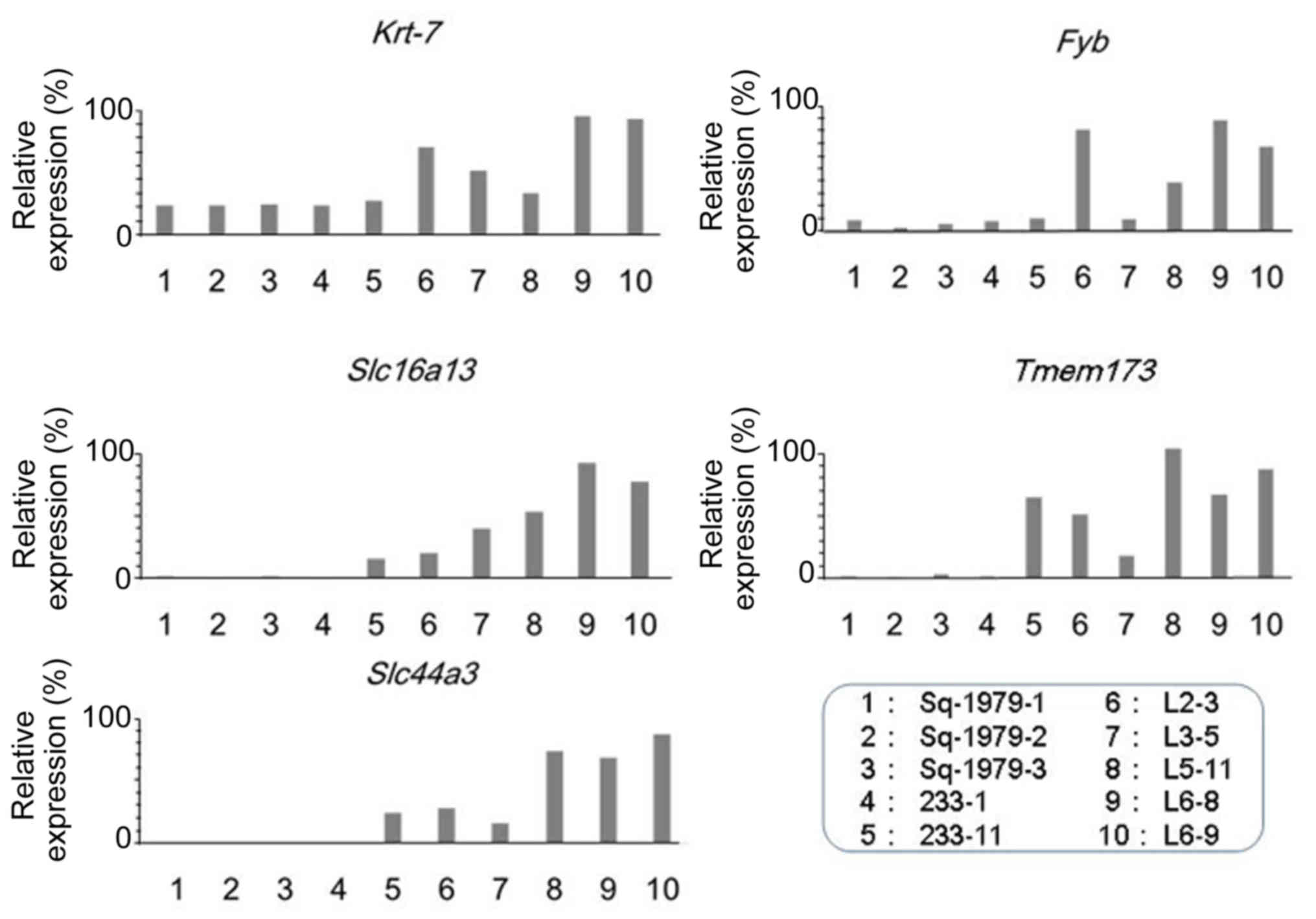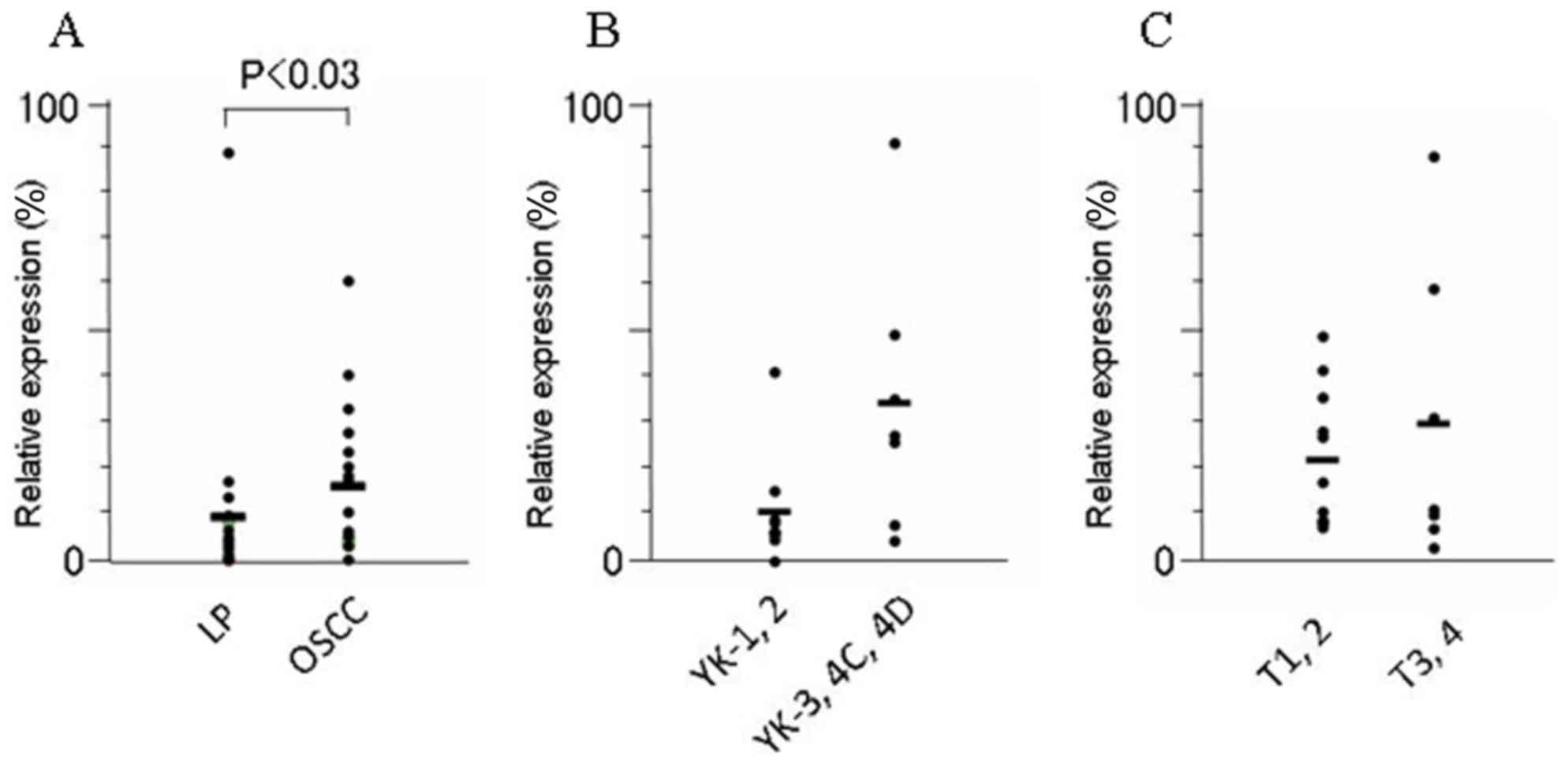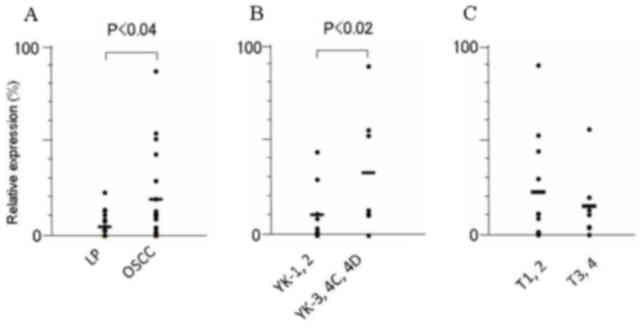|
1
|
Gupta S, Kong W, Peng Y, Miao Q and
Mackillop WJ: Temporal trends in the incidence and survival of
cancers of the upper aerodigestive tract in Ontario and the United
States. Int J Cancer. 125:2159–2165. 2009. View Article : Google Scholar : PubMed/NCBI
|
|
2
|
Leemans CR, Braakhuis BJ and Brakenhoff
RH: The molecular biology of head and neck cancer. Nat Rev Cancer.
11:9–22. 2011. View
Article : Google Scholar : PubMed/NCBI
|
|
3
|
Ohkura S, Kondoh N, Hada A, Arai M,
Yamazaki Y, Sindoh M, Takahashi M, Matsumoto I and Yamamoto M:
Differential expression of the keratin-4, −13, −14, −17 and
transglutaminase 3 genes during the development of oral squamous
cell carcinoma from leukoplakia. Oral Oncol. 41:607–613. 2005.
View Article : Google Scholar : PubMed/NCBI
|
|
4
|
Kondoh N, Ohkura S, Arai M, Hada A,
Ishikawa T, Yamazaki Y, Shindoh M, Takahashi M, Kitagawa Y,
Matsubara O and Yamamoto M: Gene expression signatures that can
discriminate oral leukoplakia subtypes and squamous cell carcinoma.
Oral Oncol. 43:455–462. 2007. View Article : Google Scholar : PubMed/NCBI
|
|
5
|
Yamamoto E, Kohama G, Sunakawa H, Iwai M
and Hiratsuka H: Mode of invasion, bleomycin sensitivity, and
clinical course in squamous cell carcinoma of the oral cavity.
Cancer. 51:2175–2180. 1983. View Article : Google Scholar : PubMed/NCBI
|
|
6
|
Kaihara T, Kusaka T, Kawamata H, Oda Y,
Fujii S, Morita K, Imura J and Fujimori T: Decreased expression of
E-cadherin and Yamamoto-Kohama's mode of invasion highly correlates
with lymph node metastasis in esophageal squamous cell carcinoma.
Pathobiology. 69:172–178. 2001. View Article : Google Scholar : PubMed/NCBI
|
|
7
|
Nakayama A, Ogawa A, Fukuta Y and Kudo K:
Relation between lymphatic vessel diameter and clinicopathologic
parameters in squamous cell carcinomas of the oral region. Cancer.
86:200–206. 1999. View Article : Google Scholar : PubMed/NCBI
|
|
8
|
Jacobson PA, Enoroth CM, Killander D,
Moberger G and Mårtensson B: Histologic classification and grading
of malignancy in carcinomaof the larynx. Acta Radiol Ther Phys
Biol. 12:1–8. 1973. View Article : Google Scholar : PubMed/NCBI
|
|
9
|
Kondoh N, Ishikawa T, Ohkura S, Arai M,
Hada A, Yamazaki Y, Kitagawa Y, Shindoh M, Takahashi M, Ando T, et
al: Gene expression signatures that classify the mode of invasion
of primary oral squamous cell carcinomas. Mol Carcinog. 47:744–756.
2008. View
Article : Google Scholar : PubMed/NCBI
|
|
10
|
RIan Freshney: Culture of animal cells: A
manual of basic technique and specialized applications. 6th.
Hoboken, N.J.: Wiley-Blackwell; pp. 208–211. 2010
|
|
11
|
Klopp AH, Zhang Y, Solley T,
Amaya-Manzanares F, Marini F, Andreeff M, Debeb B, Woodward W,
Schmandt R, Broaddus R, et al: Omental adipose tissue-derived
stromal cells promote vascularization and growth of endometrial
tumors. Clin Cancer Res. 18:771–782. 2012. View Article : Google Scholar : PubMed/NCBI
|
|
12
|
da Silva AJ, Li Z, de Vera C, Canto E,
Findell P and Rudd CE: Cloning of a novel T-cell protein FYB that
binds FYN and SH2-domain-containing leukocyte protein 76 and
modulates interleukin 2 production. Proc Natl Acad Sci USA. 94:pp.
7493–7498. 1997; View Article : Google Scholar : PubMed/NCBI
|
|
13
|
Workman P, Aboagye EO, Balkwill F, Balmain
A, Bruder G, Chaplin DJ, Double JA, Everitt J, Farningham DA,
Glennie MJ, et al: Guidelines for the welfare and use of animals in
cancer research. Br J Cancer. 102:1555–1577. 2010. View Article : Google Scholar : PubMed/NCBI
|
|
14
|
Brierley JD, Gospodarowicz MK and
Wittekind C: TNM classification of malignant tumours. 8th. New
York: Wiley-Blackwell; pp. 2722016
|
|
15
|
Lewin B, Siu A, Baker C, Dang D, Schnitt
R, Eisapooran P and Ramos DM: Expression of Fyn kinase modulates
EMT in oral cancer cells. Anticancer Res. 30:2591–2596.
2010.PubMed/NCBI
|
|
16
|
Li X, Yang Y, Hu Y, Dang D, Regezi J,
Schmidt BL, Atakilit A, Chen B, Ellis D and Ramos DM:
Alphavbeta6-Fyn signaling promotes oral cancer progression. J Biol
Chem. 278:41646–41653. 2003. View Article : Google Scholar : PubMed/NCBI
|
|
17
|
Engelmann S, Togni M, Thielitz A,
Reichardt P, Kliche S, Reinhold D, Schraven B and Reinhold A: T
cell-independent modulation of experimental autoimmune
encephalomyelitis in ADAP-deficient mice. J Immunol. 191:4950–4959.
2013. View Article : Google Scholar : PubMed/NCBI
|
|
18
|
Li C, Li W, Xiao J, Jiao S, Teng F, Xue S,
Zhang C, Sheng C, Leng Q, Rudd CE, et al: ADAP and SKAP55
deficiency suppresses PD-1 expression in CD8+ cytotoxic T
lymphocytes for enhanced anti-tumor immunotherapy. EMBO Mol Med.
7:754–769. 2015. View Article : Google Scholar : PubMed/NCBI
|
|
19
|
SIGMA Type 2 Diabetes Consortium, ;
Williams AL, Jacobs SB, Moreno-Macías H, Huerta-Chagoya A,
Churchhouse C, Márquez-Luna C, García-Ortíz H, Gómez-Vázquez MJ,
Burtt NP, et al: Sequence variants in SLC16A11 are a common risk
factor for type 2 diabetes in Mexico. Nature. 506:97–101.
2014.PubMed/NCBI
|
|
20
|
Huang B, Song JH, Cheng Y, Abraham JM,
Ibrahim S, Sun Z, Ke X and Meltzer SJ: Long non-coding antisense
RNA KRT7-AS is activated in gastric cancers and supports cancer
cell progression by increasing KRT7 expression. Oncogene.
35:4927–4936. 2016. View Article : Google Scholar : PubMed/NCBI
|
|
21
|
Paquette C, Mills AM and Stoler MH:
Predictive value of cytokeratin 7 immunohistochemistry in cervical
low-grade squamous intraepithelial lesion as a marker for risk of
progression to a high-grade lesion. Am J Surg Pathol. 40:236–243.
2016.PubMed/NCBI
|
|
22
|
Si LL, Lv L, Zhou WH and Hu WD:
Establishment and identification of human primary lung cancer cell
culture in vitro. Int J Clin Exp Pathol. 8:6540–6546.
2015.PubMed/NCBI
|
|
23
|
Chatterjee D, Das A and Radotra BD:
Invasive micropapillary carcinoma of urinary bladder: A
clinicopathological study. Indian J Pathol Microbiol. 58:2–6. 2015.
View Article : Google Scholar : PubMed/NCBI
|
|
24
|
Sano M, Aoyagi K, Takahashi H, Kawamura T,
Mabuchi T, Igaki H, Tachimori Y, Kato H, Ochiai A, Honda H, et al:
Forkhead box A1 transcriptional pathway in KRT7-expressing
esophageal squamous cell carcinomas with extensive lymph node
metastasis. Int J Oncol. 36:321–330. 2010.PubMed/NCBI
|
|
25
|
Regauer S, Beham A and Mannweiler S: CK7
expression in carcinomas of the Waldeyer's ring area. Hum Pathol.
31:1096–1101. 2000. View Article : Google Scholar : PubMed/NCBI
|












